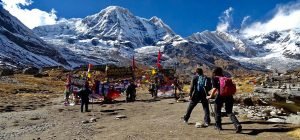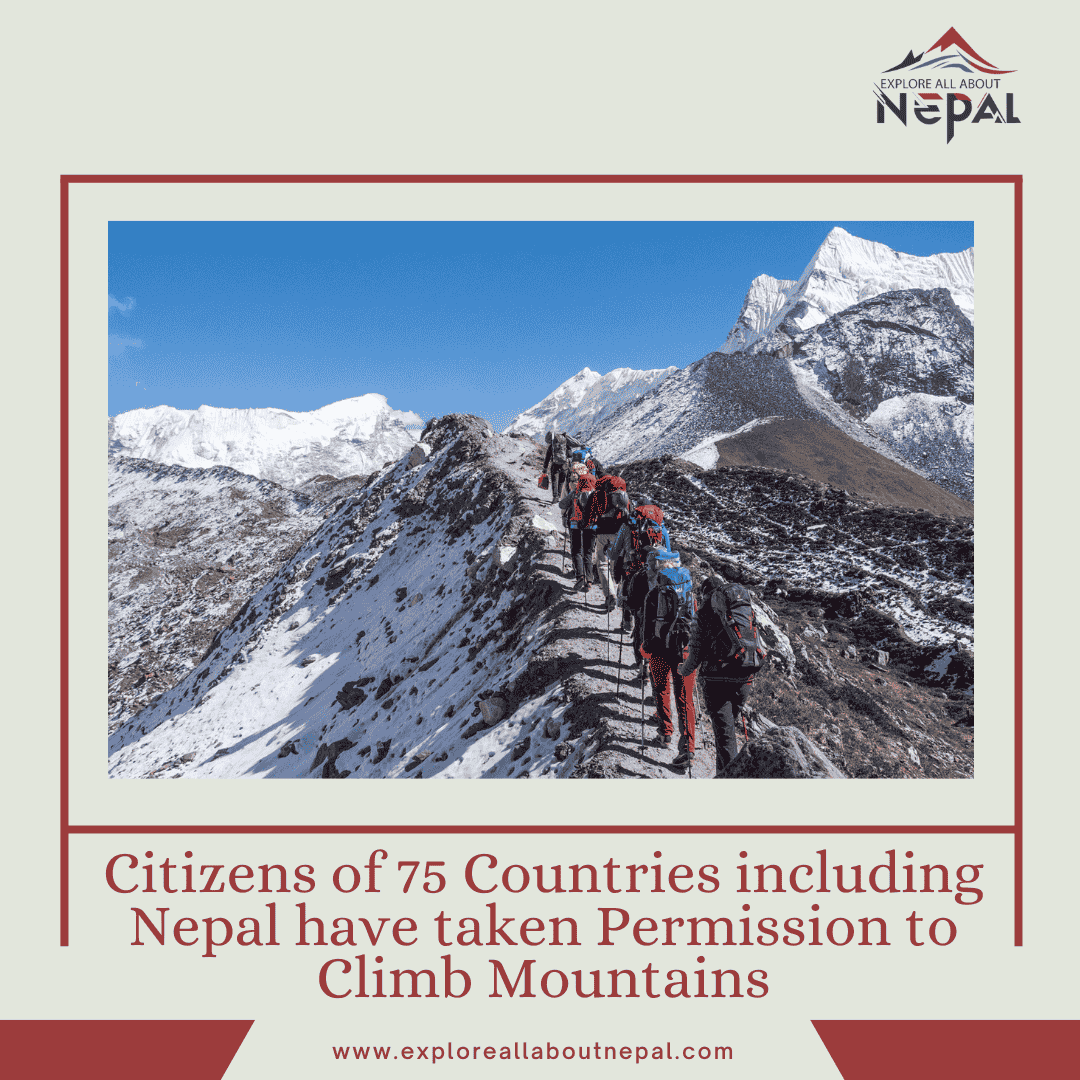Permission to Climb Mountains refers to the official authorization or permit granted by the government or relevant authorities to individuals or expedition groups, allowing them to ascend specific mountains or peaks. In Nepal, for example, the Department of Tourism issues climbing permits for various mountains, including popular ones like Mount Everest, Annapurna, and Manaslu.
Nepal, the land of the Himalayas, has once again become the epicenter of global mountaineering enthusiasm. In a remarkable development, citizens from 75 countries, including Nepal, have secured permits to climb various peaks during the recent climbing seasons. This surge in interest not only underscores Nepal’s status as a premier mountaineering destination but also highlights the country’s economic reliance on tourism and the challenges of sustainable mountain management.

The Allure of Nepal’s Mountains
Nepal boasts eight of the world’s ten highest peaks, including the towering Mount Everest (8,848 meters), making it a magnet for climbers worldwide. The diverse range of mountains caters to both novice and seasoned climbers, offering routes with varying degrees of difficulty and cultural richness. Beyond the physical challenge, these peaks provide spiritual and cultural experiences, drawing adventurers from all corners of the globe.
Permission to Climb Mountains
Permission to climb mountains is a formal authorization granted by the government or relevant authorities to individuals or expedition groups seeking to ascend designated peaks. In Nepal, climbers are required to obtain permits from the Department of Tourism for specific mountains, including Everest and other high-altitude peaks. This system is in place to regulate the number of climbers, ensure safety, protect the environment, and maintain the cultural integrity of the regions surrounding these mountains. The permit process involves submitting an application, paying necessary fees, and fulfilling safety and logistical requirements, such as hiring licensed guides. The revenue from these permits also contributes to the local economy and conservation efforts.
Climbing Season Statistics
In the spring season of 2024, Nepal’s Department of Tourism issued permits to 414 climbers from 41 groups to ascend Mount Everest. This group comprised 75 women and 339 men. Comparatively, the previous year saw a higher number, with 478 permits issued. Overall, the season witnessed a total of 971 mountaineers from 112 groups receiving permits for 30 different mountains, generating approximately NPR 674.7 million in revenue, with Mount Everest alone contributing NPR 592.3 million.
The autumn season of 2024 mirrored this enthusiasm, with 839 foreign climbers from 69 countries obtaining permits to scale 37 peaks, excluding Mount Everest. Notable among these peaks were Manaslu, Dhaulagiri, Makalu, and Cho Oyu. The climbers’ nationalities were diverse, with the United States, China, France, Russia, and Germany having the highest representations.
Economic Impact of Mountaineering Tourism
The influx of climbers significantly bolsters Nepal’s economy. Permit fees, which are a primary revenue source, have seen substantial growth. In the spring of 2024, the Department of Tourism collected NPR 674.7 million in permit fees, with Mount Everest contributing NPR 592.3 million. This revenue supports various sectors, including hospitality, transportation, and local businesses, highlighting the symbiotic relationship between mountaineering and Nepal’s economic development.
Challenges and Sustainability Concerns
While the economic benefits are evident, the surge in climbers presents challenges:
Environmental Degradation: Increased foot traffic can lead to trail erosion, waste accumulation, and habitat disruption.
Overcrowding: Popular peaks, especially Mount Everest, have experienced overcrowding, leading to safety concerns and diminished experience quality.
Cultural Impact: The influx of tourists can strain local communities and traditions, necessitating measures to preserve cultural integrity.
Regulatory Measures and Court Ruling
Addressing these challenges, Nepal’s Supreme Court, in late April 2024, ordered the government to limit the number of climbing permits issued for Everest and other peaks. The court emphasized respecting the mountains’ carrying capacity and mandated the establishment of appropriate maximum limits. This decision aims to balance economic interests with environmental and cultural preservation.
Additionally, the court restricted helicopter usage, permitting them only for emergency rescues, to reduce environmental impact and preserve the mountains’ sanctity. These measures reflect a growing commitment to sustainable tourism and responsible mountaineering.
Government Initiatives and Future Outlook
The Nepal Tourism Board has introduced several initiatives to promote sustainable tourism:
Mandatory Guide Policy: Since April 2023, all foreign trekkers and climbers are required to hire licensed guides. This policy aims to enhance safety, provide employment opportunities, and ensure that tourism benefits local communities.
Permit System Reforms: The introduction of the Trekkers’ Information Management System (TIMS) card has streamlined the permit process, ensuring better tracking and management of tourists.
Environmental Campaigns: Collaborations with NGOs and local communities focus on cleaning trekking routes, promoting responsible waste disposal, and educating tourists about environmental conservation.
Highlights
To scale Nepal’s peaks, climbers must first obtain Permission to Climb Mountains from the Department of Tourism.
Permission to Climb Mountains is a legal requirement for all climbers seeking to ascend peaks like Mount Everest.
The government has strict regulations regarding Permission to Climb Mountains to ensure the safety of all mountaineers.
Obtaining Permission to Climb Mountains is part of Nepal’s effort to manage the growing number of adventurers on its peaks.
The Permission to Climb Mountains process includes paying a permit fee and meeting other requirements such as hiring a guide.
In recent years, Permission to Climb Mountains has become more challenging to secure due to the increased number of applicants.
Many mountaineers have criticized the high cost of Permission to Climb Mountains, especially for popular peaks like Annapurna.
Permission to Climb Mountains is often granted for specific climbing seasons, ensuring the best weather conditions for expeditions.
Climbers must apply for Permission to Climb Mountains well in advance, as permits for popular peaks can sell out quickly.
Permission to Climb Mountains helps ensure that climbers are well-prepared and have the necessary permits for high-altitude trekking.
The government recently introduced new measures to regulate Permission to Climb Mountains in response to overcrowding at Everest Base Camp.
Obtaining Permission to Climb Mountains is only the first step; climbers must also pass a rigorous health check to ascend to the higher altitudes.
Permission to Climb Mountains not only ensures safety but also helps fund conservation and waste management efforts on the mountains.
Foreigners wishing to trek in Nepal must apply for Permission to Climb Mountains at the local tourism office before embarking on their journey.
Permission to Climb Mountains is required for both summiting peaks and trekking in restricted areas, which helps maintain a balance between tourism and environmental conservation.
Conclusion
Nepal’s mountains continue to captivate climbers worldwide, with citizens from 75 countries, including Nepal, actively participating in mountaineering activities. While this trend brings economic prosperity, it also necessitates thoughtful management to preserve the natural and cultural heritage of these majestic peaks. Through a combination of regulatory measures, community involvement, and sustainable tourism practices, Nepal strives to maintain its status as a premier mountaineering destination while ensuring the well-being of its environment and communities.
FAQs
How many climbers received permits for Mount Everest in the spring of 2024?
A total of 414 climbers, including 75 women and 339 men from 41 groups, received permits for Mount Everest in the spring of 2024.
Which countries had the highest number of climbers in Nepal’s autumn 2024 season?
The United States (73 climbers), China (72), and France (69) had the highest number of climbers in Nepal’s autumn 2024 season.
What measures has Nepal taken to ensure sustainable mountaineering?
Nepal has implemented policies such as requiring licensed guides for all foreign trekkers, introducing the TIMS card system, and limiting the number of climbing permits to protect the environment and cultural sites.
ExploreAllAboutNepal – Your trusted guide to travel updates and expert trekking support. Let’s make your Nepal dream a reality.


